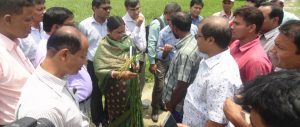Dry Direct-Seeded Rice Increases Profitability in Bangladesh

DHAKA, Bangladesh (CSISA) – The Cereal Systems Initiative for South Asia (CSISA) recently organized field demonstrations to show how using direct-seeded rice (DSR) instead of transplanting rice crops not only minimizes water use but also reduces production cost and increases profitability. This event created significant awareness of, and interest in, DSR technologies among policymakers and farmers.
Bangladesh has attained self-sufficiency in rice production, according to the Bangladesh Bureau of Statistics (BBS). In 2015–16, rice occupied 74% of the country’s total cropped area, 15.44 million hectares, and total paddy (rough rice) production was 52 million tons.
Sustaining rice self-sufficiency will require the country to produce about 20 percent more, or 10 million more tons of paddy, by 2025 to feed the expected population of 169 million people. This increase must occur despite the steady decline in cultivated land area, reduction in availability of groundwater, declining profitability and increasingly erratic climate.
In Bangladesh, rice grows throughout the year in three seasons popularly known as Aus (March–July), Aman (June–November) and Boro (November–May), with the majority of production occurring in the Boro season. Rice in Aus and Aman is mainly rainfed but fully irrigated during Boro. More than 80% of irrigated areas rely on groundwater, which is decreasing over time due to unregulated use, leading to a lack of irrigation water at the end of the Boro season across a large part of the country and driving up irrigation costs, reducing the profitability of Boro rice.
Diversifying cropping and production systems with nutritious and low water crops would save groundwater, but could reduce the total volume of rice production. To minimize rice shortages, previously uncultivated areas during Aus and Aman seasons may need to be cultivated.
Considering the important contribution of Aus rice to Bangladesh’s rice production levels, CSISA began testing mechanized DSR during the 2016 Aus season on 17 hectares in the United States Agency for International Development’s Feed the Future Zone in southern Bangladesh.
Based on the successful results of the use of this technology, CSISA began an awareness campaign for farmers, stakeholders and policymakers. High-level officials of the Bangladesh Rice Research Institute (BRRI) and the Department of Agricultural Extension (DAE) visited the DSR fields and exchanged ideas with farmers.
The promotion of mechanized Aus DSR directly supports the government priority to increase Aus cultivation and farm mechanization. Both public and private organizations have shown significant interest in Aus DSR and a willingness to work with CSISA.
CSISA has therefore targeted this region for DSR rice in Aus season where over 400 two-wheel tractor-based direct sowing machines are currently in use by service providers, and another 500 units are shipping to Bangladesh from CSISA partner RFL, an agricultural machinery importer and manufacturer.
CSISA will work with BRRI, DAE, non-government organizations and machinery dealers to further raise awareness of DSR technology, aggregate farmer demand for emerging service providers, and scale out the technology. CSISA will facilitate market linkages to ensure quality inputs, particularly seeds and herbicides and with millers and traders to help farmers sell their rice.
The wider dissemination and adoption of DSR in Aus will save water use, reduce labor requirements, lower production cost, and increase the profitability of rice farming.
The Cereal Systems Initiative for South Asia is led by the International Maize and Wheat Improvement Center and implemented jointly with the International Food Policy Research Institute and the International Rice Research Institute.
This article was authored by M. Murshedul Alam, Sharif Ahmed and Humnath Bhandari
Photos credit: Md. Khairul Islam Rony
